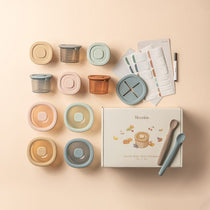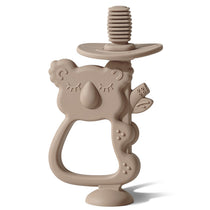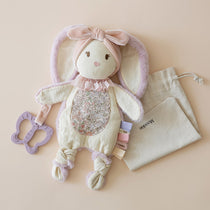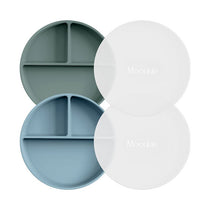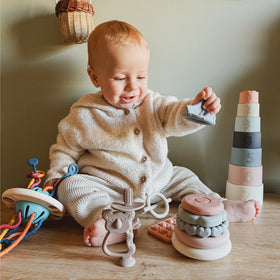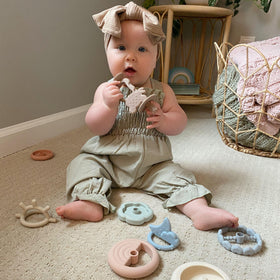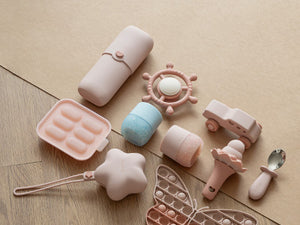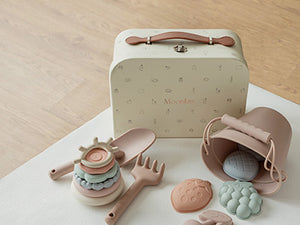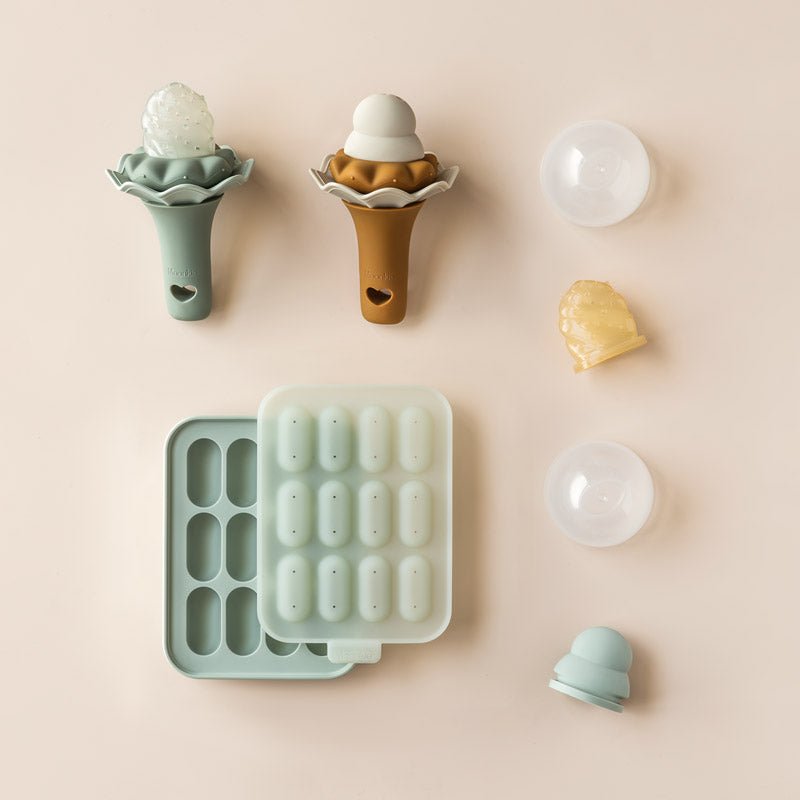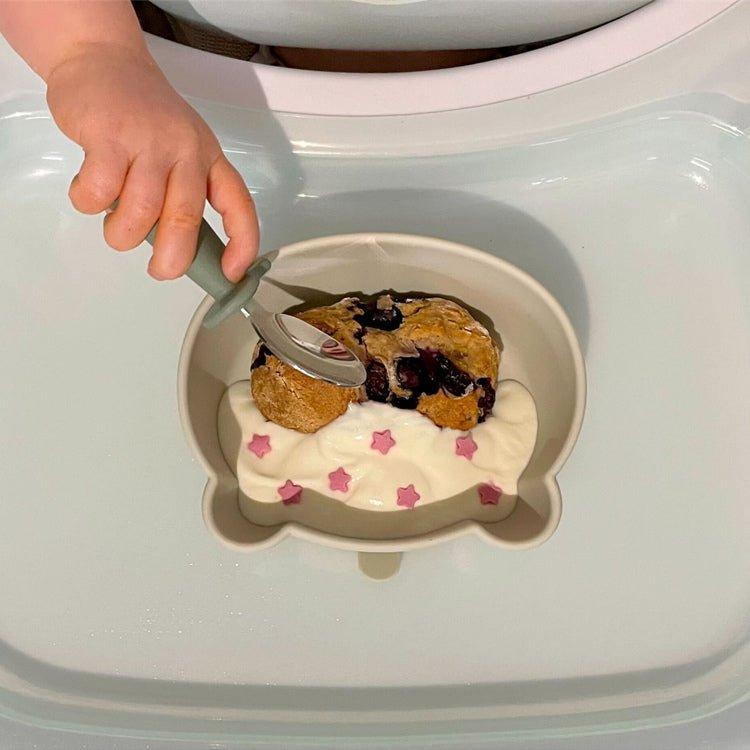
Introducing solid foods is one of the most fun experiences parents have with their baby. From adorably hilarious dislike faces to GIVE-ME-MORE responses, solid food introductions are a milestone for the books! But when is the best time to start? What do you try? And how do you begin?
According to the American Academy of Pediatrics, most babies can typically start eating solid foods at four months old, but it is better to wait until around six months old (source). However, every baby is different; you should always consult your pediatrician before starting solids.
For such a basic life skill, a lot of thought and care goes into starting a baby on solid food. Let's get to it!
When Should I Begin Introducing Solid Food to My Baby?
The AAP recommends introducing solids around six months of age but no earlier than four months old (source). However, every baby is different, so it's a good idea to consult with your pediatrician before starting solids.
The AAP has guidelines to help parents determine when their little one is ready to embark on their first culinary adventure. If your baby can do all of the following and has a green light from the pediatrician, then he is ready for solid food (source):
- sits up alone (or with a bit of support)
- able to control head and neck without aid
- tries to grab small objects
- brings objects to mouth without prompting
- opens mouth when food is given
- moves food from the front to the back of the tongue to swallow
-
swallows food instead of pushing it out of the mouth
Can I Introduce Solid Food Before My Baby Is Four Months Old?
No, breast milk or formula should be the main nutrition source for babies until they are six months old. According to the World Health Organization (WHO), a baby should be totally breastfed for the first six months to pull off optimal growth, development, and health (source).
Think about it: breast milk is safe, contains all the nutrients your baby needs, and contains nifty antibodies that help protect your little one from illness (source). Breast milk is powerful stuff, and it helps your little one for as long as you are willing to feed her!
But even if breastfeeding is not an option, baby formula is the next best thing until six months of age. Part of this is due to your little one's digestive system's maturity and ability to break down solid food to get the nutrients he needs.
Do the AAP and the WHO Disagree on When to Start Solids?
So, if the WHO says your baby should wait for solids until six months old, why does the APA say your baby can start eating solids if she is physically ready at four months old? This difference in recommendation simply sets guidelines for what's best and what's possible.
If your little one is breastfeeding, awesome! Start introducing solids during family meal times whenever she's physically ready and interested in doing so. Do likewise for formula babies.
But for those few babies who struggle with eating, gaining enough weight, or feeling satisfied with the amount of milk they are getting, starting solids between four and six months may be necessary just to keep up with baby's needs if the pediatrician recommends it.
What Types of Solid Foods Should I Try?
When it comes to what to try, it's essential to introduce a variety of food to help develop your baby's taste buds and ensure she's getting all the necessary nutrients. Though you could start with the run-of-the-mill rice cereal or pureed fruits and vegetables, why not try something like pureed avocado blended with fruit or sweet potato blended with kale?
You can also try adding common spices like cinnamon or cumin down the road to introduce new flavors. Just get creative and enjoy it! Introducing a large variety of foods early on can help prevent picky eating later in life (source). However, you should introduce only one new food at a time and watch for signs of an allergic reaction.
Here is a list of typical starters for early food explorers:
1. Rice Cereal
Pediatricians often recommend iron-fortified cereals like rice cereal as a first food because they are a good source of iron. According to online reports by the Centers for Disease Control and Prevention (CDC), iron-fortified cereals are easy to digest and provide all-important nutrients for tiny tummies (source).
Breastfeeding babies get plenty of iron until around six months old. After that, their not-as-tiny bodies need another source of iron through solid food to keep up with growth. However, formula-fed babies typically get plenty of iron through their formula until they are around twelve months old (source).
Iron-rich solid foods you can make for your little one include cooked red meat, fish, chicken, turkey, eggs, beans, and dark green leafy vegetables. Again, introduce one of these at a time to check for allergic reactions, and ask your pediatrician for food your baby needs specifically.
2. Pureed Fruit
Pureed fruits like apples, pears, bananas, or peaches are classic options for babies because they are easy to digest and naturally sweet. Your little one's eyes will light up with these sweet treats!
Some babies don't like the tartness of pureed berries at first, which is totally fine! Try blending the berries with breastmilk or formula milk to see if it makes them palatable. My babies quickly overcame any initial food aversions if I blended tart flavors with bananas.
3. Pureed Vegetables
Sweet potato, squash, carrot, and pea purees are not enjoyable for teenagers doing "Guess What This Is" baby food challenges but tasty for baby foodies.
Vegetable purees are easy to make, packed with nutrients, easy on the belly, and can be mixed with some breast milk or formula to create a smooth puree. Don't avoid giving your little one veggie purees because you hate peas; he hasn't decided for himself yet!
4. Avocado
Avocados are an exceptional source of healthy fats and can be blended with breast milk or formula to make the puree much smoother. Thanks to its creamy texture and taste, avocados blend well with bananas, leafy greens, berries, peaches, pears, mango, sweet potatoes, zucchini, oats, and seasonings.
Avocado purees will brown quickly, but they keep well in the freezer if you divide the puree into ice cube trays or silicone cups and place an airtight lid on them within a few minutes of blending. You may like avocado purees, too!
5. Spices
At first, you don't have to add sugar, salt, or seasonings to your little one's purees because she doesn't know the difference yet. She is just interested in tasting all the things. As the weeks go on, you can start introducing spices like cinnamon or cumin to their purees.
Of course, a little goes a long way for baby, so don't overdo seasonings and spices just yet! Wait until she has a few solid foods she enjoys regularly before you begin spicing things up.
And just as you do with solid foods, only introduce one spice per meal to test for allergic reactions like hives, rash, swelling, vomiting, or diarrhea. If you notice any of these, stop giving her that food and contact your pediatrician right away.
Don't Feed Your Baby Honey
There are so many unique foods for your baby to try, but one that may not be obvious to avoid is honey. Don't feed your baby honey until she is over twelve months old. The problem is a bacteria called Clostridium that causes infant botulism, which can cause muscle weakness, constipation, and a weak cry.
If you think your baby ate some honey from a well-meaning sibling, friend, or family member, call your pediatrician immediately for symptoms to look for and what to do next.
Is Homemade Baby Food a Good Idea?
Making delicious homemade baby food can be a superb way to ensure your baby is getting fresh, nutritious food. If you enjoy cooking at home, it can be fun and cost-effective, too!

Here are some beginner tips for making homemade baby food:
1. Invest in a Nice Blender or Food Processor
A fantastic, reliable blender or food processor makes a world of difference! Look for one with positive reviews for use, durability, ease of cleaning, and puree smoothness.
You can even opt for a baby food maker that will steam and puree the food all in one cycle!
2. Choose Fresh Ingredients
Choosing fresh ingredients is one of the culinary joys of making your own baby food! Giving your little one fresh food is integral to expanding his taste, and providing real food early on may lay the groundwork for healthier eating habits later in life.
Buy ripe fruits and veggies that are in season and organic if possible. Rinse well or peel before cooking. If you choose to buy locally from a farmer's market, you'll support local farmers, too.
3. Cook and Puree
Cook the fruits or vegetables until soft, then puree them fully in a blender or food processor. If the texture isn't smooth enough or your baby's puree seems a bit thick, try adding a little breastmilk or formula.
There are tons of free baby food recipes online that you can try to learn which fruits you need to cook before pureeing. Not all of them need to be cooked! Otherwise, steaming, boiling, or cooking before blending helps break vegetables and starchy fruits down before blending, resulting in a much smoother puree.
4. Freeze for Later Use
After a few weeks of introductions, you can simply puree whatever you are cooking yourself for dinner. One way to make early introductions and solid food meals more manageable during the week is by making large batches of baby food purees and freezing them.
Just scoop individual servings of puree into ice cube trays or silicone baby food trays with an airtight lid and freeze. Once frozen, you can pop them out into an airtight bin or bag for freezer storage and keep them for up to two or three months, depending on the ingredients.
Do Solid Foods Impact My Baby's Sleep?
Introducing solid foods will give your little one's belly new stuff to break down, inevitably resulting in more rumbles, bubbles, and gut activity. So, yes, solid foods can impact your baby's sleep, but is it for the better or the worse?
It is a long-held belief that solid foods actually help babies sleep longer because solid food takes longer to break down, leaving babies sleeping longer between night feedings.
One study in particular seems to confirm this, but the benefits came out to two fewer night wakings per week and sleeping for an average of 17 minutes more each night (source). This seemingly insignificant difference means the world at this stage of parent sleeplessness!
It is also possible, however, that your little one could stay up with an upset belly if they ate something that didn't sit well. Generally speaking, a baby's developing gut microbiome will adjust admirably to a varied solid food diet (source). So, let your little foodie explore!
Do Solid Foods Impact My Baby's Diaper Habits?
Yes, introducing solid foods can change your baby's diaper habits. As he eats more solid foods, his bowel movements may become more solid and less frequent. This is normal, but don't hesitate to talk to your pediatrician if you have any concerns.
Sometimes, your little one will have lumps of food in his diaper. Grape skins, carrots, and corn are the common culprits. Ideally, you will either avoid these or cook them down and puree them before giving them to your baby. Cut grapes into little pieces before serving them to your baby.
Feeding Cues: Hunger and Fullness
Paying attention to your baby's cues is essential when it comes to giving him solid food. Look for signs that he's hungry, like smacking his lips or reaching for food. On the flip side, watch for signs that he's full, like turning his head or pushing food away.
Let your baby guide the feeding process, and don't force him to eat if he's not interested. Also, don't make him finish the last few bites! Trying to make him do so will only lead to unhealthy eating habits later (source).
Moonkie Silicone Feeding Set
One skill your baby needs to learn is using a spoon to scoop food out of a bowl or off a plate. As you can imagine, spoon skills are a messy lesson to learn! You can make cleanup super easy with Moonkie's soft, durable, easy-to-clean silicone feeding set.

We thought of everything when we designed this 14-piece feeding set!
| Item | Benefits |
| 1 silicone suction plate |
|
| 1 first-stage infant drinking cup |
|
| 2 silicone baby food containers |
|
| 1 infant feeding spoon |
|
| 1 silicone baby bib |
|
| 1 silicone placemat |
|
| 1 silicone suction bowl |
|
| 2 self-feeding utensils (spoon + fork) |
|
Even better, every piece can easily be tossed into the dishwasher for cleaning!
In a Nutshell
Introducing your baby to solid foods is such a fun experience that only lasts a short time. Try out a variety of foods, get into making homemade baby food, keep tabs on what your little one likes, and consult your pediatrician if anything seems odd. Enjoy taking your little foodie into this new world of possibilities!


